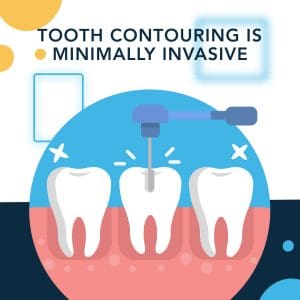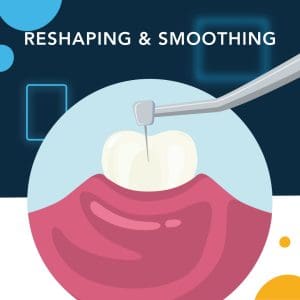Whether it’s smoothing out chips, evening out lengths, or adjusting slight overlaps, tooth contouring offers an immediate transformation of your smile. Although it offers many aesthetic benefits, like most medical procedures, it also carries certain risks. In this article, we will explore both the advantages and potential downsides of cosmetic tooth contouring and provide you with a comprehensive overview to help you determine if this treatment is right for you.
What is Tooth Contouring?
Tooth contouring, also known as dental reshaping, is a cosmetic dental procedure that involves removing small amounts of the outer layer of tooth enamel to change a tooth’s shape, length, or surface. It is typically used to correct minor imperfections such as:
- Irregularly shaped teeth
- Slight overlaps
- Pointy canines
- Small chips
- Long teeth
- Short teeth
- Smooth surface imperfections
The process is usually fast and painless, often improving the appearance of one’s smile in just one session by creating more balance and symmetry.
Who is a Good Candidate for Tooth Reshaping?
Tooth contouring is a cosmetic dental procedure that is suitable for individuals with minor dental issues such as small chips, bulges, or irregular tooth shapes. However, it is important to note that it is not appropriate for those with decaying teeth, root canals, or unhealthy gums. Ideal candidates should have healthy teeth with sufficient enamel, as the procedure involves removing small amounts of it. A dental consultation is necessary to determine if tooth contouring is a safe and suitable option based on your specific dental condition.
Benefits of Tooth Contouring
Tooth reshaping offers several benefits, making it a popular choice for cosmetic dental improvement. It is a quick and painless procedure that can immediately enhance your smile by correcting minor imperfections such as chips, cracks, and overlapping teeth. Additionally, it is cost-effective compared to other dental procedures and typically does not require ongoing dental visits for maintenance.
Minimally Invasive Procedure
Tooth contouring is a minimally invasive cosmetic procedure that involves subtle changes to the teeth by removing slight amounts of enamel. This gentle sculpting process does not require anesthesia and typically has no recovery time, making it a straightforward solution for enhancing the smile without the need for more extensive dental work.
Cost-Effective
Compared to other cosmetic dental procedures, such as veneers or orthodontics, contouring is a more budget-friendly option and offers instant results. It’s an excellent choice for people looking to make minor adjustments to their teeth without spending a lot of money.
Quick & Convenient
Tooth contouring is a quick and convenient cosmetic dental procedure, often completed in just one visit. The process requires minimal preparation and no recovery time, allowing patients to return to their daily activities immediately. Its efficiency makes it an ideal choice for busy individuals looking to improve their smile with minimal disruption.
Permanent Results
Teeth reshaping is a valuable long-term investment in your smile because it provides permanent results. By carefully reshaping the enamel, the changes made to the tooth’s structure are irreversible, ensuring that the improved appearance of the teeth endures over time without the need for retreatment. This permanence adds to its appeal as a cosmetic dental solution.
Are There Any Risks Involved?
Although tooth contouring is generally safe, there are some risks associated with the procedure. If too much enamel is removed, the tooth can be more susceptible to breakage and decay. Additionally, any mistakes made during the reshaping process are irreversible since enamel cannot be replaced. To reduce the potential risks, it is essential to have this procedure performed by an experienced dental professional. When searching for a dentist near me in Broward County, it’s important to do thorough research to find a reputable cosmetic dentist.
Tooth Sensitivity
Following tooth contouring, patients may experience increased sensitivity to hot and cold temperatures. This occurs because the procedure involves removing a small amount of enamel and exposing the dentin underneath, which is more sensitive to temperature changes.
Weakened Tooth Structure
Since tooth contouring involves removing enamel, the overall structure of the tooth can be weakened in the process. This is because the removed enamel serves as a protective layer. As a result, the tooth becomes less resilient against physical stresses, which can lead to chips or cracks in the future.
Irreversible Procedure
Tooth contouring is an irreversible process. Once the enamel is removed, it cannot be restored, which means any changes made are permanent. Patients need to consider the long-term implications of altering their tooth structure before proceeding with this cosmetic treatment.
Minor Cosmetic Changes
Tooth contouring is a cosmetic dental procedure best suited for minor adjustments to tooth appearance. If you need significant changes in tooth shape or alignment, more extensive dental treatments such as orthodontics or veneers may be more appropriate. It is important to note that tooth contouring is not a suitable option if you want to drastically alter the size and shape of your teeth.
Risk of Damage to Pulp
If a dentist removes too much enamel during contouring, it can potentially harm the tooth’s pulp, which is the central part containing nerves and blood vessels. This damage can lead to more serious problems, such as the need for a root canal or, in severe cases, tooth extraction.
Not Suitable for Everyone
Tooth contouring is not suitable for everyone. It is best for individuals with minor cosmetic flaws. Those with decay, weakened enamel, or significant structural damage are not good candidates for this procedure, as it could lead to further dental problems. A thorough evaluation by a dental professional is necessary to determine eligibility.
How Does Tooth Reshaping Work?
During the tooth reshaping process, a dentist uses tools such as drills or lasers to precisely scrape off small amounts of enamel from a tooth to alter its shape. The process is planned carefully using X-rays and up-to-date dental impressions to ensure precision. From the initial consultation to final polishing, a dentist takes many steps to improve the tooth’s appearance when performing this procedure.
Initial Consultation
During the initial consultation for tooth reshaping, the dentist evaluates the patient’s dental health and aesthetics through physical examination and X-rays. This session is crucial for discussing the patient’s cosmetic goals and assessing whether tooth contouring is an appropriate solution, ensuring expectations align with achievable outcomes.
Marking Imperfections
The next step in tooth reshaping involves marking the imperfections that need correction. The dentist uses a special pencil to carefully highlight areas on the teeth that will be sculpted. This precise marking guides the reshaping process, ensuring that only the necessary amounts of enamel are removed to achieve the desired result.
Removing Enamel
After marking imperfections, the dentist will remove small amounts of enamel using fine diamond burs or sanding discs. This step is performed with great care and precision to sculpt the tooth into the desired shape, smoothing out imperfections and adjusting contours. The amount of enamel removed is minimal, preserving the tooth’s integrity while enhancing its appearance.
 Reshaping & Smoothing
Reshaping & Smoothing
After removing the necessary enamel, the dentist proceeds to reshape and smooth the tooth. This involves further refining the shape and smoothing out any rough edges to ensure the tooth blends seamlessly with its neighbors. This final contouring is crucial for achieving a natural and visually pleasing result that enhances the overall smile.
Polishing
The final step in the tooth reshaping process is polishing the teeth. After the contouring is complete, the dentist uses a fine polishing tool to smooth the surface of the reshaped teeth, giving them a natural shine and finish. This not only improves the appearance but also helps prevent plaque accumulation on the newly contoured surfaces.
Is Tooth Contouring Painful?
Tooth contouring is generally not painful as it involves only the enamel, which does not contain nerves. Most patients experience no discomfort during the procedure. However, some might feel slight sensitivity when the enamel is being removed, especially if it’s close to the underlying dentin or the gums. Typically, anesthesia is not required, making tooth contouring a tolerable and quick cosmetic option.
Post Procedure Sensitivity
While tooth contouring itself is not painful, some patients may experience sensitivity following the procedure. This sensitivity is usually temporary and occurs as the teeth adjust to the minor loss of enamel. It can manifest as a heightened response to hot, cold, or sweet stimuli but typically resolves on its own within a few days to a week.
How Does Tooth Contouring Compare to Other Cosmetic Dental Procedures?
Tooth contouring stands out among cosmetic dental procedures due to its non-invasive nature and immediate results. Unlike veneers or crowns, which cover or replace parts of a tooth, reshaping alters the existing structure without the need for prosthetics. It’s also more cost-effective and requires less time and recovery than more extensive cosmetic treatments.
Veneers
Veneers and tooth contouring are two dental procedures that enhance dental aesthetics, but they differ in their purpose and the processes involved. Veneers are thin covers that attach to the front surface of a tooth, and they are ideal for making major transformations to the appearance of teeth. On the other hand, tooth contouring involves removing small amounts of enamel to refine the shape of a tooth. While veneers offer more dramatic changes, they are also more invasive and costly compared to the subtler, less expensive reshaping procedure.
Dental Bonding
Dental bonding and tooth contouring both address cosmetic dental issues, but they use different methods. Bonding involves applying a resin to the tooth to correct imperfections, then shaping and hardening it with light. It’s ideal for larger repairs like chips or gaps. Contouring, on the other hand, subtly reshapes the tooth by removing enamel, making it less suitable for extensive modifications. Bonding can alter a tooth’s entire appearance, whereas contouring fine-tunes it.
Crowns
Crowns are an excellent option for teeth that have suffered severe damage or decay. They cover the entire tooth, providing comprehensive protection. Alternatively, dental contouring is a cosmetic procedure that reshapes teeth with minor imperfections. Crowns are an ideal choice for structural support and durability while reshaping is a quick solution for cosmetic enhancement.
Orthodontics
Orthodontics and tooth reshaping address cosmetic concerns differently. Orthodontics, such as braces or aligners, corrects teeth alignment and bite issues over months or years, making substantial changes to oral structure and function. Tooth contouring provides immediate aesthetic improvements by reshaping and smoothing minor imperfections in a single visit without altering the overall alignment of the teeth.
Teeth Whitening
Teeth whitening and teeth contouring both enhance the smile but focus on different aspects. Whitening treatments target and remove stains for a brighter smile, affecting the color of the teeth without altering their shape. Contouring reshapes and smooths the teeth’s edges to improve their form, not color, providing a more defined and aesthetically pleasing outline.
Schedule a Dental Checkup Appointment
Regular dental checkups are necessary for maintaining optimal oral health and preventing potential dental issues from turning into major problems. During these checkups, your dentist in Plantation, Florida, can conduct thorough cleanings, identify early signs of tooth decay, gum disease, or other oral health concerns, and provide options for cosmetic dentistry procedures or orthodontic services. Call our office to schedule your next appointment with a Plantation dentist today.
September 13, 2024

 Adult
Adult




 Reshaping & Smoothing
Reshaping & Smoothing